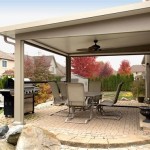Best Ways to Repair a Concrete Patio
Concrete patios, known for their durability and versatility, are a popular choice for outdoor living spaces. However, exposure to the elements, fluctuating temperatures, and general wear and tear can lead to cracks, spalling, and other forms of damage. Addressing these issues promptly is crucial to prevent further deterioration and maintain the patio's structural integrity and aesthetic appeal. Selecting the appropriate repair method depends on the type and severity of the damage, as well as the desired outcome and budget. This article explores several effective techniques for repairing concrete patios, providing a comprehensive guide for homeowners and professionals alike.
Understanding Common Concrete Patio Problems
Before detailing repair methods, it's essential to recognize the common problems that affect concrete patios. Understanding the root cause of the damage is critical for selecting the most effective repair strategy. Ignoring the underlying issues will likely lead to recurring problems, necessitating repeated repairs and potentially a more costly replacement in the long run.
Cracking: Cracks are perhaps the most prevalent issue affecting concrete patios. They can range from hairline fractures to wide, deep fissures. Causes vary, including shrinkage during the initial curing process, ground movement, overloading, and freeze-thaw cycles. Shrinkage cracks are common in newer patios and usually pose little structural threat if they remain narrow and stable. However, wider cracks, particularly those accompanied by vertical displacement, may indicate more serious structural problems.
Spalling: Spalling, characterized by the flaking or crumbling of the concrete surface, is another common issue. It often results from water penetration, followed by freezing and thawing. As water freezes, it expands, creating internal pressure that can weaken the concrete and cause it to break apart. The use of de-icing salts can exacerbate this process, as the salts draw moisture into the concrete and accelerate its deterioration. Poor drainage and inadequate sealing also contribute to spalling.
Surface Scaling: Surface scaling is similar to spalling but involves the loss of a thinner layer of surface concrete. It’s frequently caused by improper finishing techniques during the initial construction, such as overworking the surface while it's still wet or using excessive amounts of water during the finishing process. Surface scaling can also result from exposure to harsh chemicals or abrasive cleaning methods.
Settlement: Uneven settling of the underlying soil can cause sections of the patio to sink or tilt. This can lead to significant cracking and create tripping hazards. Settlement can be caused by poor soil compaction during construction, erosion, or changes in soil moisture content.
Staining and Discoloration: While primarily aesthetic, staining and discoloration can detract from the appearance of a concrete patio. Stains can be caused by a variety of substances, including leaves, rust, oil, and mildew. Discoloration can also occur due to variations in the concrete mix or exposure to sunlight.
Repairing Cracks in Concrete Patios
Addressing cracks promptly is crucial to prevent water infiltration and further damage. The appropriate repair method depends on the width, depth, and stability of the crack. Hairline cracks may only require sealing, while wider or deeper cracks may require more extensive repairs.
Sealing Hairline Cracks: Hairline cracks (less than 1/8 inch wide) are typically cosmetic and can be sealed with a concrete crack sealant. These sealants are available in various formulations, including acrylic latex, polyurethane, and epoxy. Before applying the sealant, thoroughly clean the crack with a wire brush to remove any loose debris. Apply the sealant according to the manufacturer's instructions, ensuring it fills the crack completely. Excess sealant can be wiped away with a damp cloth.
Filling Narrow Cracks: Narrow cracks (1/8 to 1/4 inch wide) can be filled with a concrete patching compound or a self-leveling sealant. Concrete patching compounds are typically cement-based and require mixing with water. Self-leveling sealants are usually polyurethane-based and are formulated to flow easily into the crack. To prepare the crack, clean it thoroughly and slightly dampen the concrete surface. Apply the patching compound or sealant, ensuring it fills the crack completely. Smooth the surface with a trowel or putty knife to match the surrounding concrete. Allow the repair to cure according to the manufacturer's instructions.
Repairing Wide Cracks: Wide cracks (greater than 1/4 inch wide) require more extensive repairs. One common method involves using a concrete patching compound and reinforcing mesh. Clean the crack thoroughly and remove any loose debris. If the crack is deep, fill it partially with gravel or sand to reduce the amount of patching compound required. Apply a layer of patching compound, then embed a piece of reinforcing mesh into the compound. Add another layer of patching compound to cover the mesh completely. Smooth the surface and allow the repair to cure. For larger cracks, consider using a concrete epoxy injection. This involves injecting epoxy resin into the crack to bond the concrete back together. Epoxy injection requires specialized equipment and expertise and is best left to professionals.
Crack Chasing: For irregular or jagged cracks, consider crack chasing. This involves using a concrete saw or grinder to widen and create a uniform channel along the crack. This provides a better surface for the patching material to adhere to. After chasing the crack, clean it thoroughly and fill it with a concrete patching compound or self-leveling sealant as described above.
Repairing Spalled Concrete Patios
Spalling requires removing the damaged concrete and replacing it with a patching material. The repair process involves several steps, including preparation, mixing the patching compound, applying the compound, and curing the repair.
Preparation: The first step is to remove all loose and deteriorated concrete from the affected area. Use a hammer and chisel or a concrete grinder to remove the spalled concrete down to a sound base. Undercut the edges of the repair area slightly to create a mechanical bond for the patching compound. Clean the area thoroughly with a wire brush and a pressure washer to remove any debris, dust, or loose particles. Apply a bonding agent to the prepared surface. This will improve the adhesion of the patching compound to the existing concrete.
Mixing the Patching Compound: Choose a concrete patching compound that is appropriate for the size and depth of the repair. Follow the manufacturer's instructions for mixing the compound. Typically, this involves adding water to a dry mix and mixing thoroughly until a smooth, workable consistency is achieved. Avoid adding too much water, as this can weaken the patching compound.
Applying the Compound: Apply the patching compound to the prepared area, filling it completely and slightly overfilling it to allow for shrinkage. Use a trowel to compact the compound and ensure it adheres to the bonding agent. Smooth the surface of the patch to match the surrounding concrete. For larger repairs, apply the patching compound in layers, allowing each layer to partially cure before adding the next.
Curing the Repair: Proper curing is essential for ensuring the strength and durability of the repair. Keep the patched area moist for several days by covering it with plastic sheeting or damp burlap. This will prevent the patching compound from drying out too quickly, which can lead to cracking and reduced strength. Follow the manufacturer's instructions for the recommended curing time.
Addressing Settlement Issues
Settlement issues are often more complex and may require professional intervention. Minor settlement can sometimes be addressed by patching and leveling the affected area. However, more significant settlement may require raising the sunken slab or replacing the entire patio section.
Patching and Leveling: For minor settlement, a self-leveling concrete compound can be used to raise the sunken area to match the surrounding concrete. Clean the area thoroughly and apply a bonding agent. Pour the self-leveling compound into the depression, allowing it to flow and fill the void. Use a trowel to smooth the surface and ensure it blends seamlessly with the existing concrete. Allow the compound to cure according to the manufacturer's instructions.
Slab Jacking: Slab jacking is a process that involves injecting grout or foam beneath the sunken slab to raise it back to its original level. This method is typically used for larger settlement issues. A professional slab jacking company will drill small holes in the concrete slab and inject the grout or foam through these holes. As the grout or foam expands, it lifts the slab back into position. Slab jacking can be a cost-effective alternative to replacing the entire patio section.
Replacing the Patio Section: In cases of severe settlement or extensive damage, replacing the affected section of the patio may be the best option. This involves removing the damaged concrete, preparing the subgrade, and pouring new concrete. Ensure proper compaction of the subgrade to prevent future settlement. Use reinforcing steel to strengthen the new concrete slab. Properly curing the new concrete is essential for ensuring its strength and durability.
By understanding the common problems that affect concrete patios and employing the appropriate repair techniques, homeowners can maintain the beauty and functionality of their outdoor living spaces for years to come. Regular maintenance, including cleaning and sealing, can help prevent future damage and extend the lifespan of the patio.

5 Ways To Fix Ed Or Damaged Concrete Patio Cricket Pavers

Fix Your Ugly Concrete

Concrete Patio Repair 5 Ways To Improve Your

Arlington Heights Concrete Repair Hero

The Best Way To Fix A Ed Patio

The Best Way To Repair A Ed Or Damaged Concrete Patio Arrak

How Can I Salvage A Crumbling Ed 24x24 Triangle Shaped Concrete Patio Without Tearing It Out Hometalk

Concrete Patching How To Bond Existing For Best Results Sakrete

How To Repair Concrete S Nonprofit Home Inspections

How To Repair Concrete Patios Resurfacing Sealing Resin
Related Posts








